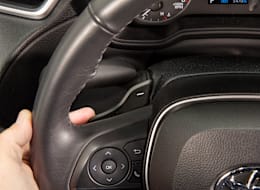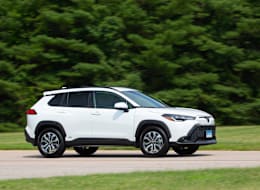The hybrid version of Toyota’s Corolla Cross subcompact SUV has more power and refinement and much better fuel economy than the conventional model. As such, we think the $2,000 or so extra that it costs to get the hybrid (which comes standard with all-wheel drive) over the regular model is well worth it, and makes it the no-brainer choice between the two.
The Corolla Cross is a smaller alternative to Toyota’s RAV4 SUV. This pseudo-wagon is functional, has mostly straightforward controls, and is easy to get in and out of. The slightly elevated seating position and large windows make for airy outward visibility for the driver, and there’s plenty of headroom in both the front and rear seating positions.
While the hybrid version is the superior choice, it doesn’t massively transform the Corolla Cross. For example, although it doesn’t feel underpowered like the regular model does, the electronic continuously variable transmission (eCVT) makes for some unrefined situations, as it allows the noisy gas engine to rev quite high when real acceleration is called for. Plus, the front seats offer just mediocre comfort, and the cheap-looking cabin remains.
A big positive of most hybrids is that they give a smooth shove of electric power off the line, and that’s the case with the Corolla Cross. Drive it with a normal amount of pressure on the gas pedal and the engine typically comes on in a seamless fashion at around 10 to 15 mph. The hybrid’s additional 27 horsepower on hand—between the 2.0-liter four-cylinder and electric drive—means that the gas engine isn’t as stressed as often as with the regular model. And when loafing around town, or anytime you’re using a light throttle foot, the engine revs stay low and the powertrain feels fine.
It’s a different story when you’re looking for some extra speed, though; in those moments, the gas engine bursts to life in a startlingly loud fashion. It doesn’t help that the eCVT allows the engine revs to hold at around 4,000 rpm or so during regular acceleration, without any of the simulated upshifts that can be found with the nonhybrid Corolla Cross, until the car gets up to speed. Worse, those higher engine revs bring lots of noise, along with vibrations that can be felt coursing through the steering wheel.
But the positives outweigh the negatives. The Corolla Cross Hybrid shaves about 1.5 seconds off the conventional model’s run from 0 to 60 mph, accomplishing the task in 7.7 seconds, which is quick for the class. And simulated upshifts or not, it’s hard to argue with 41 mpg overall—a massive 13-mpg gain over the regular model. If you’re looking at a Kia Niro that gets 45 mpg overall, remember that it’s only available with front-wheel drive—important for those who typically get snow during the winter months.
Similar to the conventional version, the Corolla Cross Hybrid feels a bit clumsy and uninspiring during regular driving, with body roll that becomes noticeable pretty quickly if you pick up the pace. We found the hybrid a little more composed over mid-corner bumps, and overall it showed a bit more responsiveness. It posted a competitive 54.5-mph speed through our accident-avoidance test, although that’s a notable 3.5-mph drop from the regular Corolla Cross—which itself was admittedly a standout performance among subcompact SUVs.
Ride comfort is slightly more settled than the regular model. The suspension absorbs smaller road imperfections well, but large potholes still strike through to the cabin in a noticeable way. By virtue of the added power and the car’s ability to propel itself on silent electric power at low speeds, the cabin can at times be quieter than the regular model, except for when the engine kicks on during hard acceleration.
Unlike many hybrids we’ve tested, which exhibit longer stopping distances than their nonhybrid counterparts, the Corolla Cross Hybrid actually stopped shorter from 60 mph on both our dry and wet surfaces than the regular model. The brake pedal feels more “normal” than many Toyota hybrids, although there’s still some grabbiness at low speeds from the regenerative braking system.
There’s lots of headroom up front but the driver’s seat has limited adjustments (you have to step up to the top Hybrid XSE to get adjustable lumbar), and it loses support and comfort during longer drives. Plus, both the door- and center armrests are woefully under-padded, and the plastic center console infringes on the driver’s right-knee space. Although the rear seat has ample headroom, the bottom cushion is sorely short on leg support.
The interior is rather humdrum, with lots of hard-plastic surfaces with a few rough edges here and there. Cargo capacity is modest compared to most small SUVs, though the vehicle’s upright shape gives it good practicality and usefulness considering its small footprint. Plus, we’re happy to see that the hybrid doesn’t lose any cargo capacity compared to the regular Corolla Cross. A ride height that falls in between a low-slung sedan and most small SUVs makes it pretty easy to get in and out, and slim roof pillars most of the way around contribute to good outward visibility.
Unfortunately, Toyota’s latest infotainment system isn’t as easy to use as past versions—some audio and phone tasks require extra steps on the touchscreen. But overall, most controls are relatively user-friendly, including the physical climate knobs and buttons (rather than touch-capacitive icons on a panel), and we appreciate that the Corolla Cross Hybrid comes standard with wireless Android Auto and Apple CarPlay.
The Corolla Cross Hybrid comes with the “Toyota Safety Sense 3.0” suite of active safety and driver assistance features, which includes automatic emergency braking with pedestrian, bicyclist, and motorcycle detection; automatic emergency braking that operates at highway speeds, lane centering assistance, lane departure warning, lane keeping assistance, adaptive cruise control, and automatic high beams. Unfortunately, blind spot warning and rear cross traffic warning aren’t available on the base Hybrid S, although both of these important active safety features come standard on higher trims.


























